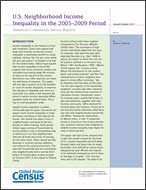U.S. Neighborhood Income Inequality in the 2005-2009 Period
U.S. Neighborhood Income Inequality in the 2005-2009 Period
Introduction
Income inequality is one measure of societal conditions. Some have argued that large (and recently increasing) income inequality is potentially harmful to social stability—letting “the rich get richer while the poor get poorer” is thought to be bad for the United States. Others have argued that income inequality is one of the engines that drives economic growth and innovation and taxing away the incomes of those at the top end of the income distribution can stifle creativity and lower the well-being of everyone. This paper will not take a position as to the benefits or costs of income inequality, or examine the changes in inequality over time at a local level, but rather it will examine the extent to which income inequality differs spatially inside the United States, focusing on small geographic areas.
Spatial income inequality is neither intrinsically bad nor good. One would not expect much income inequality in neighborhoods consisting of new high-priced houses. Nor would one expect much in neighborhoods consisting of low-rent private or public housing. Some would indeed argue sorting of households by income within a city or metropolitan area is natural as it is a rare neighborhood that has all kinds and prices of housing. On the other hand, others would say that diversity in incomes among neighbors can enhance the social environment. The idea that households will sort themselves into neighborhoods with a narrow distribution of income dates at least as early as Thurow (1971) if not indeed to Tiebout (1956).
Income sorting might have negative consequences for the poor. Wheeler (2008) notes “The movement of high-income individuals away from the poor, for example, may leave the poor with relatively few jobs (e.g., Kain 1968) or reduce the extent to which the rich confer positive spillovers on the poor (e.g., Wilson 1987 and Benabou 1996).” Watson (2009) argues that “Income sorting affects the distribution of role models, peers, and social networks” and that “the characteristics of one’s neighbors and peers in school affect outcomes.” But, as Hardman and Ioannides (2004) state, “For the vast majority of US households, neighbors’ incomes and other characteristics are the market-driven outcome of individual choices. Households’ tastes for housing space, quality and access to jobs and amenities, together with their incomes and assets, define demand for housing types and locations. Prices set in the housing market determine what housing units and neighborhoods households can afford.” Among the implications, as Watson notes, is that “if residential choice is sensitive to the income distribution, economic policies that moderate or amplify income inequality may shape the cities in which we live.”
This paper will start at the national level to give the overall context for the level of U.S. income inequality and drill down through states and large cities to neighborhoods—here defined as census tracts (designed by local officials and experts to be relatively homogenous and to have an average of roughly 1,500 housing units and 4,000 people). The data to do so became available in December 2010—when the first-ever income inequality estimates were released for neighborhoods from the American Community Survey (ACS).1 Those period estimates cover the years 2005 through 2009 and thus average together the final years of economic growth in the first decade of the 21st century with the first years of downturn.2
The ACS was designed as a replacement for the Census 2000 long form—the previous source of neighborhood characteristics such as median household income. As an annual survey of roughly 3 million addresses, it provides an annual portrait of the demographic, social, economic, and housing characteristics of small towns, neighborhoods, and population groups. As part of their data dissemination, the Census Bureau publishes estimates on the Internet for median household income and for the Gini index of household income inequality (the Gini index ranges from 0.0, when all households have equal shares of income, to 1.0, when one household has all the income and the rest none).3
__________
1 Thus the census tracts boundaries are defined as of 2000, for use with that census. Data released in late 2011 from the ACS will use the 2010 Census tract boundaries.
2 Income is asked of respondents about the prior 12-month period, so interviews in January 2005 covered calendar year 2004 income, and interviews in December 2009 covered income for December 2008 through November 2009. The National Bureau of Economic Research dates the most recent recession as December 2007 to June 2009.
3 For more information on measurement of income in the ACS and on the Gini index of inequality, see Bishaw and Semega 2008.
Others in Series
Publication
Publication
Publication




